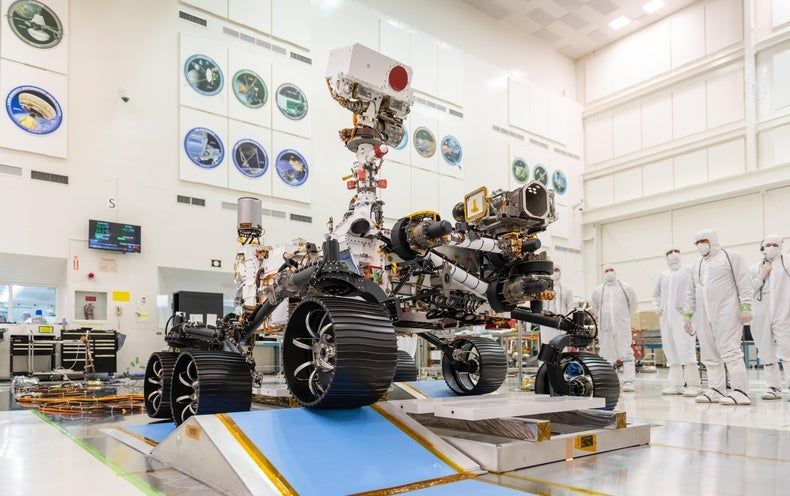A SpaceX Crew Dragon capsule arrived on Florida’s Space Coast on Thursday (Feb. 13), completing a cross-country trek from the company’s California headquarters.



The space industry is in the midst of a widespread transformation, as the last decade has seen several young, private companies seek to profit in areas historically dominated by governmental interests. Among these areas is lunar mining, which represents a crucial step for the development of the space economy by enabling the utilization of lunar resources. Though significant opportunities exist for wealth creation and societal benefits, it will require sustained multibillion-dollar investment to develop a vibrant lunar mining industry.
Exploration is the essential first step for any mining endeavor, terrestrially or otherwise, but with the technical challenges of lunar mining largely solved, access to capital has become the prevailing constraint. While the uncertainty of operating in space is the commonly used explanation for capital constraints, in reality, terrestrial explorers have seen funding steadily decline for a decade, with investors favoring lower risk, passive exposure to the mining sector. For lunar mining firms seeking to attract capital for exploration, this essay details the incompatibility of traditional investment options, the financing strategies developed by the similarly cash-strapped terrestrial mining industry, and how prospective lunar miners should capitalize on emerging trends in project finance.

LOS ANGELES (AP) — Virgin Galactic’s spaceship VSS Unity, tucked under the wing of its special carrier aircraft, took a long-awaited ferry flight Thursday from Southern California to its new home in the New Mexico desert, where it will undergo final testing in preparation for commercial operations that will carry tourists on hops into space.
The mothership, named Eve, took off from Mojave Air & Space Port and circled over the Mojave Desert before turning east toward Spaceport America in southern New Mexico. The flight lasted more than three hours, giving pilots a chance to evaluate the spaceship at high altitude and cold temperatures for a prolonged period of time.
The move to New Mexico marks a significant milestone toward commercial flights, which the company anticipates this year.

A favorite theme of science fiction is “the portal”—an extraordinary opening in space or time that connects travelers to distant realms. A good portal is a shortcut, a guide, a door into the unknown. If only they actually existed…
It turns out that they do, sort of, and a NASA-funded researcher at the University of Iowa has figured out how to find them.
“We call them X-points or electron diffusion regions,” explains plasma physicist Jack Scudder of the University of Iowa. “They’re places where the magnetic field of Earth connects to the magnetic field of the Sun, creating an uninterrupted path leading from our own planet to the sun’s atmosphere 93 million miles away.”


For example, less than an hour after CNBC first reported Gerstenmaier’s hiring, the head of Russian state space corporation Roscosmos, Dmitry Rogozin, tweeted his congratulations: “I wish my friend success in his new job!”
In his new position, Gerstenmaier is reporting to Hans Koenigsmann, the vice president of mission assurance at SpaceX. Although the role is officially a consultancy, it is expected to become a full-time position. SpaceX is poised to launch the first crewed mission of its Dragon spacecraft by June of this year. Gerstenmaier will play a key role in ensuring the safety of those missions and helping SpaceX secure certification for the Crew Dragon vehicle.
The hiring could have longer-term implications as well. Few people in the global aerospace community have as much gravitas as Gerstenmaier or as much understanding of how to build coalitions to explore space. As SpaceX seeks partners—including NASA—to work with it on developing Starship to take humans to the Moon and Mars, Gerstenmaier is well-positioned to offer advice, stitch together mission plans, and open key doors.

Featured Image Source: David Stokes
SpaceX aims to launch NASA Astronauts to the International Space Station for the first time this year aboard their updated Dragon spacecraft, known as Crew Dragon. The spacecraft successfully conducted the most important safety test last month during an uncrewed In-Flight Abort (IFA) mission which tested the craft’s launch escape system capabilities. During the IFA test, engineers mimicked a real flight to space except that they purposely caused their Falcon 9 rocket to “malfunction” by shutting down its 9 Merlin 1D engines in order to trigger Dragon’s launch escape countdown. Falcon 9 aerodynamically exploded mid-air, as Dragon successfully ignited its 8 SuperDraco engines to escape the danger.


Koch lands in Kazakhstan after 328 days in space, the longest continuous spaceflight by a female astronaut.
